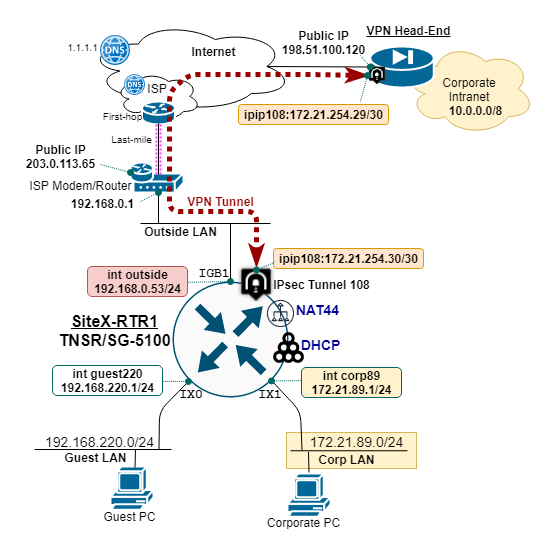Tip
This is the documentation for the 20.02 version. Looking for the documentation of the latest version? Have a look here.
Step 1: Prepare for Deployment¶
Before the deployment can begin, it is important to gather all needed hardware, software, and parameters in advance.
Prerequisites¶
Create a reference diagram that shows the logical topology.
Review the TNSR Zero-to-Ping documentation.
Whenever possible, get a static public IP address for the remote office TNSR.
If needed, set up DHCP pass-through (public IP) or set a DMZ host on the ISP Modem.
Management (web login, admin access) of the ISP modem.
Notes¶
IPsec tunnels work best on a static and public IP address.
NAT-T is not currently supported on TNSR.
Some dynamic ISP services may provide a relatively stable IP address but this will break the IPsec tunnel if the IP address changes.
Reference Diagram¶
Create and maintain a reference diagram to support the deployment, as shown in the example below:

TNSR remote office reference diagram¶
Remote Office Deployment Parameters¶
Define and document the deployment parameters for the initial remote office setup, as shown in the example below:
Parameter |
Value |
|---|---|
TNSR Hostname |
siteX-rtr1 |
TNSR Outside Interface IP |
192.168.0.53/24 |
TNSR Outside Public IP |
203.0.113.65/24 |
Guest LAN Name |
guest220 |
Guest LAN IP |
192.168.220.1/24 |
Guest DHCP Range |
100-199 |
Guest DNS IP |
1.1.1.1,9.9.9.9 |
Corporate LAN Name |
corp89 |
Corporate LAN IP |
172.21.89.1/24 |
Corporate DHCP Range |
100-199 |
Corporate DNS IP |
10.10.10.75,1.1.1.1 |
In this example, the Remote Office is deployed behind an ISP cable modem performing NAT.
TNSR Outside IP is different than the ISP Modem Public IP address
ISP cable modem provides NAT for inside devices, which includes the TNSR outside inteface
IPsec uses IP Protocol 50 (ESP) to transfer encrypted payload
ISP cable modem may need to be configured for DMZ host set to TNSR outside IP address or inbound ESP traffic may be dropped
IPsec VPN Tunnel Parameters¶
Define and document the parameters for the corporate IPsec tunnel and IP routing configuration, as shown in the example below:
Parameter |
Value |
|---|---|
TNSR Outside IP |
192.168.0.53/24 |
TNSR Public IP |
203.0.113.65/24 |
IPsec Tunnel Peer IP |
198.51.100.120 |
IPsec Tunnel ID |
108 |
IPsec IKEv2 Crypto |
AES128/SHA1/DH14 |
IPsec IKEv2 Authen |
PRE-SHARED-KEY |
IPsec Child SA Crypto |
AES128GCM16/DH14 |
IPsec Tunnel IP |
172.21.254.30/30 |
IPsec Tunnel Next-hop |
172.21.254.29 |
Corporate IP Block |
10.0.0.0/8 |